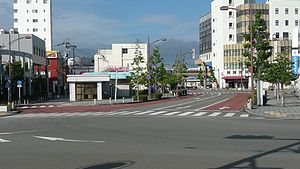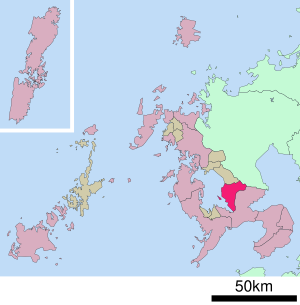Ōmura (Nagasaki)
| Ōmura-shi 大村 市 |
||
|---|---|---|
| Geographical location in Japan | ||
|
|
||
| Region : | Kyushu | |
| Prefecture : | Nagasaki | |
| Coordinates : | 32 ° 54 ' N , 129 ° 57' E | |
| Basic data | ||
| Surface: | 126.46 km² | |
| Residents : | 95,062 (October 1, 2019) |
|
| Population density : | 752 inhabitants per km² | |
| Community key : | 42205-3 | |
| Symbols | ||
| Flag / coat of arms: | ||
| Tree : | Quercus gilva | |
| Flower : | Prunus lannesiana cv. Mirabilis | |
| town hall | ||
| Address : |
Omura City Hall 1 - 25 Kushima Omura -shi Nagasaki 856-8686 |
|
| Website URL: | http://www.city.omura.nagasaki.jp/ | |
| Location of Ōmuras in Nagasaki Prefecture | ||
Ōmura ( Japanese 大村 市 , -shi ; literally: large village ) is a city in Nagasaki Prefecture in Japan .
Every day at 6 p.m. the famous "castle" plays music in the city, comparable to church bells .
geography
The city is located in the Ōmura plain ( 大村 平野 , Ōmura-heiya ) on the Ōmura bay .
history
Like Nagasaki , Ōmura was one of the few places where the Jesuits and Portuguese could move freely in Japan .
The modern city was founded on February 11, 1942 . 33.1% of Ōmura was destroyed by the atomic bombing on Nagasaki .
Deportation prison
The Ōmura migrant detention center was set up in 1950 on parts of the site at the nearby Sasebo naval base . The accommodations were extremely dilapidated. Mainly refugees were held there, initially those who had been detained before the massacres on Cheju , organized by the troops of the US-backed dictator Syngman Rhee , then those from the Korean War, often for years without a court judgment. The Japanese government branded these refugees as " stowaways " ( mikkōsha - synonymous with "smugglers"). A nearby modern building opened in August 1996, now called Ōmura Immigration Reception Center , now performs the same function.
traffic
- Nagasaki airport
- Streets:
- Nagasaki Highway
- National roads 34, 444
- Train:
Town twinning
sons and daughters of the town
- Nagaoka Hantarō (1865–1950), physicist
- Masaki Okino (born 1996), football player
- Taira Shige (* 1993), soccer player
Neighboring cities and communities
- Nagasaki Prefecture
- Saga prefecture
Web links
Individual evidence
- ^ "East Asian version of the Nazi concentration camps ... We should not be misled by the facts that it has no gas chambers ..." Hayashi Kōzō, cit. in: Morris-Suzuki, Tessa; Borderline Japan: foreigners and frontier controls in the post-war era; Cambridge 2010; ISBN 978-0-521-86460-2 , p. 167
- ↑ Morris-Suzuki, Tessa; Borderline Japan: foreigners and frontier controls in the post-war era; Cambridge 2010; ISBN 978-0-521-86460-2 . Ch. 6



